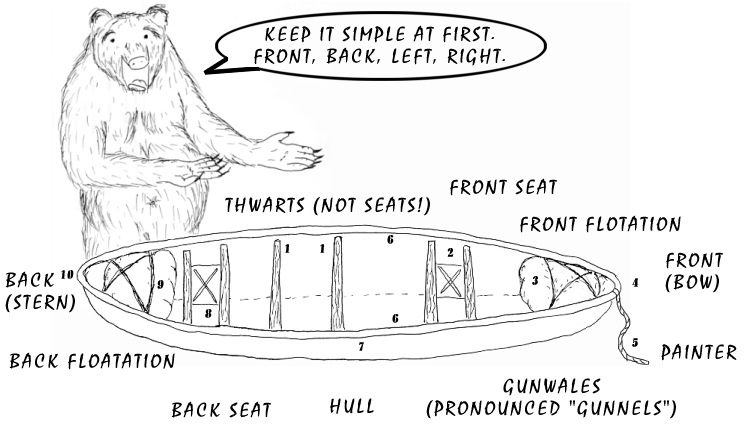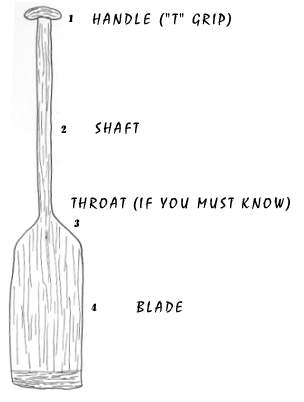

Canoe Nomanclature |

| 1. Thwarts
- These guys are not seats! They are
meant to support the canoe structurally, but not your body weight.
They are often used as a place to tie in extra gear.
Tip from Short Rope - Be careful how you tie in your gear. Makes sure that if the canoe capcizes, (flips over,) that you will not become entangled. 2. Front Seat - This is pretty self explanitory. The person in the front of the canoe is positioned here. Most of the time in a canoe, you will actually be kneeling, though. To find out why, check out The Grizz's instructional tape. 3. Front Floatation - These are sometimes called "float bags." They hold air to keep the boat buoyant if it should fill with water. Tip from Short Rope - Don't confuse "float bags" (what you fill with air) with "throw bags" (used for rescue, aka "rescue bag"). Throw bags should float, but never throw a float bag! You may argue that your canoe stays partailly afloat without floatbags in flat water. While this may be true, a canoe without floatbags in moving water is a deadly pinning hazard. A canoe full of water without floatation can weigh a thousand pounds, hundreds of pounds more than if there is floatation. A canoe full of water can easily be pinned on rocks, even if they are below the surface of the water. A person trapped between a rock and pinned canoe poses a difficult problem for rescuers. 4. Front - Hey, if you go fast enough, this will make some cool waves! 5. Painter - Don't ask us why they call it that, we have no clue. But what we do know is this length of rope is attached to the front or back of a canoe. It can be used to tie the boat to a vehicle, a tree, or as a kind of leash if you want to walk your boat along the bank. Tip from Short Rope - The painter is considered to be a piece of rescue equipment. It is useful for you or a frightened swimmer to grab-on to if you land in the water. Be aware of the length and nature of your painter, as this could become a source of entanglement. 6. Gunwales - For some reason, this word doesn't sound how it looks. It is pronounced "gunnel." This part of the boat is that annoying thing you will keep pinching your fingers against when you paddle. This can easily be avoided by good technique, or technology. A boat with "tumblehome" will not have this problem. To find out more, check out River Grizzly's instructional tape! 7. Hull - Sorry, I guess this would more simply be refered to as the "bottom." How's that for nomanclature? 8. Back Seat - This is where the person who will be "explaining how to drive" will be positioned. No, seriously. If that sounds insane, check our Grizz's tape, and we'll explain why! 9. Back Floatation - Same as front, only in the back, and definetely just as important. 10. Back -This part of the boat is often more important than the front for doing some maneuvers. If maneuvers interest you, Grizz will be more than happy to show them to you on his tape. We couldn't fit all of them on the whole internet! |
 |
1. Handle
- On this particular type of paddle, the
handle, or "grip" is called a "T" grip. There
are many other types though.
2. Shaft - This is known as a "straight shaft" paddle. There are also "bent shaft" paddles. 3. Throat - Few people know that this part has a name. It does! And if you want to impress people, you can use this word if you ever want to describe "that part where it is like curved and the shaft meets the blade." 4. Blade - This part of the paddle is in the water most of the time. Tip from Short Rope -Paddles are one of the largest sources of injury on the river. To avoid accidentally impaling your partner, splash with buckets, not with paddles. |
|